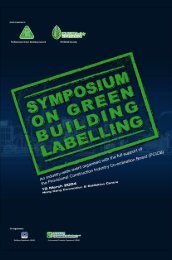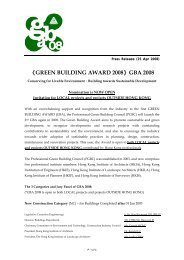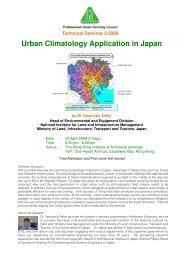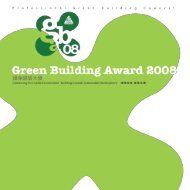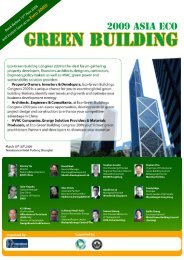10th Anniversary Booklet - The Professional Green Building Council
10th Anniversary Booklet - The Professional Green Building Council
10th Anniversary Booklet - The Professional Green Building Council
Create successful ePaper yourself
Turn your PDF publications into a flip-book with our unique Google optimized e-Paper software.
Sparkling <strong>Green</strong>156Quantitative Approach in <strong>Green</strong>ing our <strong>Building</strong>s<strong>Green</strong>ing provides benefits in enhancing the visual and aesthetic qualityof our built environment, improving air quality by absorbing air pollutantsand carbon dioxide, providing psychological comfort, reducing peak stormwaterdischarge, increasing bio-diversity and mitigating the Urban HeatIsland (UHI) effect. This article briefly describes the quantified findings ofthermal benefits in greening and the quantitative approach in the provisionof greening in building developments in Singapore and Hong Kong.<strong>The</strong>rmal Benefits of <strong>Green</strong>ing<strong>The</strong> UHI effect is a phenomenon in which the urban area is warmer than itssurrounding rural area. <strong>The</strong> UHI is mainly caused by urban area dominatedwith hard surfaces with materials which absorb and retain heat. A higherenergy consumption which generates larger amount of waste heat to theurban environment is also an important contributory factor. <strong>Green</strong>ingby means of planting vegetation in urban area is one of the effectivemitigation measures in ameliorating the UHI effect. <strong>The</strong> exterior buildingspaces provide ample opportunities for greening and these include plantingat-grade, on roofs, podia and walls of buildings.With reference to the findings in Hortpark Vertical <strong>Green</strong>ery Research andDemonstration Project in Singapore published in 2009, the results indicatedthat the temperaturedifference between the wallsurface covered with greeneryand that of the control wallwith bare surface could beas high as 12 o C (see Figure1). <strong>The</strong> findings supportedthat vegetation cover caneffectively reduce the thermalgain into buildings by shadingthe solar radiation andevapotranspiration coolingeffect of the plants.Figure 1: Temperature readings on bare control wall surface(black) as well as the wall (red) and substrate (green) surfacesof a vertical greenery wall in HortPark. (Source: Chiang K. andTan A. (2009))Energy simulations of the different scenarios of greening extent on buildingenvelope were also conducted in the research. <strong>The</strong> Envelope <strong>The</strong>rmalTransfer Value (ETTV) as adopted in Singapore is a measure of the averageheat gain into a building through its envelope. This composes of three keyheat transfer components: (1) heat conduction through opaque walls, (2)heat conduction through glass windows and (3) solar radiation throughglass windows. In the scenario of a building with full glass façade, 40%ETTV reduction could be achieved with 50% vertical greenery over theglass facade. In the scenario of a building with glass and concrete façadeat a ratio of 2:1, 13% ETTV reduction could be achieved with verticalgreenery covering the concrete façade. <strong>The</strong> findings illustrated that energyconsumption required for cooling the internal space of buildings can beeffectively lowered with greening provision on building surfaces.In the research, the daily fluctuation of the wall surface temperature ofthe control wall was recorded as approximately 10 o C while the wall withgreenery was recorded as low as 1 o C. <strong>The</strong> results showed that greeningprovision can stabilize the daily fluctuation of temperatures in the buildingsurfaces as an additional benefit. <strong>The</strong> significant reduction in dailytemperature differences of a building surface by greening can avoid theextreme daily expansion and contraction of surface building materials. Thiscan prolong the lifespan of the building materials and minimize the needfor replacement and maintenance costs of building surface.<strong>The</strong> ambient temperatures away from the surface of the control wall andthe wall with greenery were also recoded in the research. <strong>The</strong> resultsindicated that a reduction of ambient temperature could reach as high as3.3 o C at a distance 0.15m away from the surface of the wall with greenery.With the cooler ambient temperature, the air conditioning system installedin area with greening provision can take in air at a lower temperature andthus saving the energy required for cooling the internal building space.Development of <strong>Green</strong> Plot Ratio in SingaporeWith a better understanding of the benefits of greening, a sophisticatedapproach in greening provision in developments by the application of<strong>Green</strong> Plot Ratio (GnPR) is evolving in Singapore. <strong>The</strong> GnPR is the ratioof the total leaf area of all greenery in a site to the site area. It is threedimensional in nature taking account into the measurement of greenvolume instead of greening provision by number of plants or planting area.<strong>The</strong> calculation of GnPR relies on the Leaf Area Index (LAI) and canopyarea. <strong>The</strong> LAI of a plant is its one-sided leaf area per unit ground area. <strong>The</strong>canopy area of a plant is the vertical projected area of the plant’s canopyon the ground. <strong>The</strong> total leaf area of a plant species in a site is calculated bymultiplying the LAI of that species by the total canopy area covered by thatspecies. <strong>The</strong> total leaf area of all greenery in a site is the sum of total leafarea of all species planted in a site.GnPR = (total leaf area) / (site area)= (LAI1 x Canopy Area1+ LAI2 x Canopy Area2+… LAIn x Canopy Arean)(site area)<strong>The</strong> GnPR is considered as a better quantified greening measure as itis directly related to the leaves of plants which are the key componentresponsible for environmental function of greenery such as carbonassimilation, cooling by transpiration and shading. <strong>The</strong> approach in usingGnPR is to stipulate the minimum amount of “green density” in a site asappropriate to suit its land-use type.To facilitate the practical application of GnPR, the Centre for Urban<strong>Green</strong>ery and Ecology (CUGE) in Singapore developed a database of valuesfor the LAI and canopy area of 300 commonly used local landscape plants.<strong>The</strong> measurement of LAI involved (1) direct method by harvesting andmeasuring the area of all leaves in a plant within a sampled area and (2)indirect method by measuring the transmission of light through the canopyof vegetation using the plant canopy analyzer LAI-2000.<strong>The</strong> measurementof canopy area was simply by measuring the projected canopy area onground of the sampled plants. <strong>The</strong> collected data were then arranged intodifferent categories and statistical tests were conducted to derive generic



